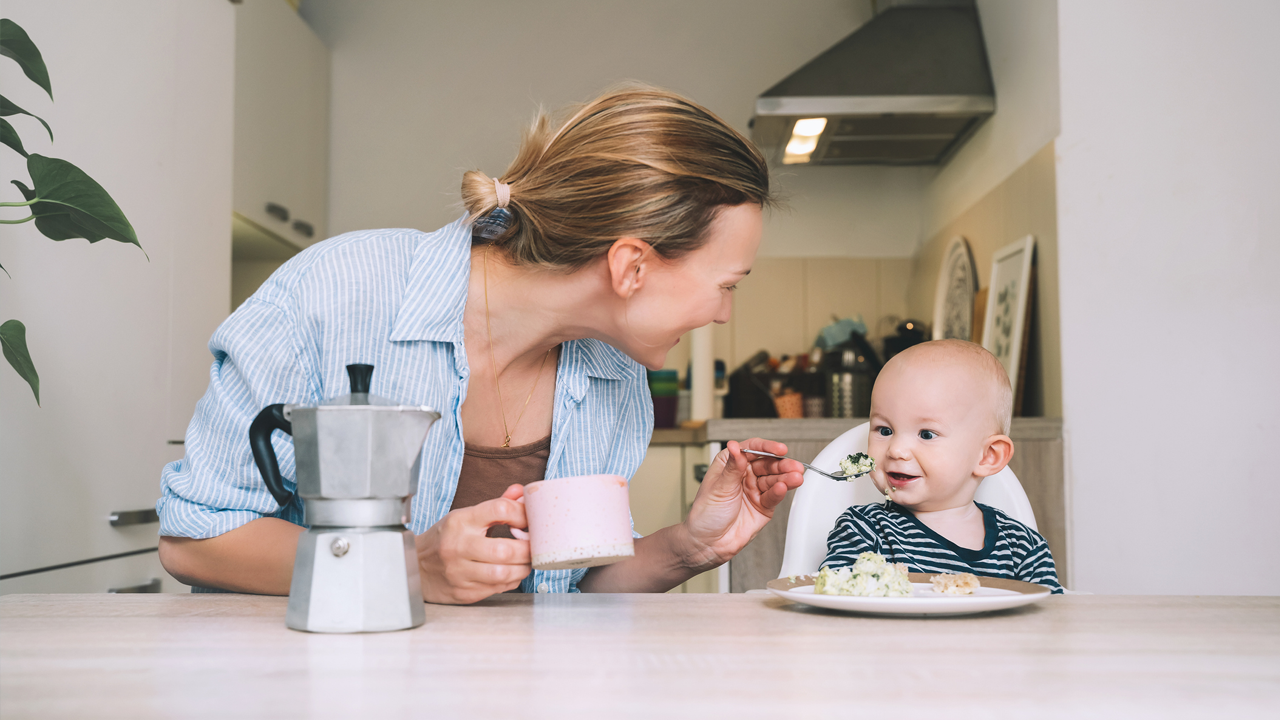Your baby is growing more active and curious. Take advantage of these wonderful qualities by building activities into his day that help him learn and grow—and keep up the nutrition he needs for all this amazing development.
Cognitive
Play pickup. Retrieve your baby’s toys when he drops them. Try to be patient, as he’ll probably do this over and over again as he experiments with cause and effect.
Provide toys that respond to your baby’s touch. If a toy makes a noise, lights up, or pops open when handled a certain way, your baby will react with surprise and delight—and work hard to figure out how to make it happen again.
Make faces in the mirror. Hold your baby in front of a mirror and make a funny face. See if he tries to touch your reflection—or realizes that the reflection is yours. Mirrors teach your baby about spatial relationships.
Watch for peekaboo developments. Your baby’s understanding of object permanence is improving, so you’re likely to see signs that he’s catching on that you’re hiding and haven’t really disappeared.
Motor
Give toys he can handle. Choose toys that your child can explore with his hands. These items improve his hand-eye coordination and dexterity. Examples include toys with handles, soft balls, blocks, stacking rings, and small, easy-to-grasp stuffed animals or dolls. Try seating your baby in a high chair even when it’s not mealtime so he can play with these kinds of toys and work on transferring them from one hand to the other.
Make diaper changes discovery times. Reserve an especially interesting toy for play during diaper changes. Ideally, it will keep him interested (and not wiggling!) for a few minutes while you change him.
Take to the water. If he can sit independently, place your baby in a bathtub with a few inches of water. The water will be a fun distraction while he practices sitting—with your constant supervision, of course.
Hit the floor. Schedule daily floor time for your baby during which he can sit, lie, or roll around on the floor and play with toys or with you.
Clear space for crawling. As your baby begins to crawl, make sure there’s a child-safe play space for him to explore. Cover electrical outlets, secure or remove dangling wires or tablecloths that he might yank, and block off stairs with child-proof gates.
Dance while holding your baby. The rhythmic movements teach him about moving the body—and he’ll love being held close to you.
Communication
Talk to your baby often. Using exaggerated speech patterns and facial expressions will help keep your baby’s attention and encourage him to babble back to you.
Respond to your baby’s babbles. Use the words she’s trying to say, but do so matter-of-factly, rather than in a correcting tone. For instance, if she says, “ba ba,” you might show her a picture of a baby and say, “Baby.”
Read board books. When your baby babbles while looking at a book in an attempt to imitate you, offer encouragement and praise for this early effort at reading
Match words with pictures. Point out pictures in books and magazines, and name what you see for your baby.
Sing nursery rhymes and songs. You baby will enjoy hearing and learning the rhyming patterns.
Ready for signs. Playing peekaboo, waving good-bye, and performing songs with gestures help prepare your baby for the idea of communicating with baby sign language. If you’d like to teach him some signs in the coming months, these actions are a good way to lay the groundwork.
Make introductions slowly. If your baby is experiencing stranger anxiety, it may take some time for him to warm up to an unfamiliar person. It helps to have the person talk to you in a warm, pleasant way before directly approaching your baby.
Welcome a “lovey.” Have your baby bring a favorite blanket or stuffed animal when he’s visiting a new place or staying with a sitter. Also called a transitional object, a lovey can boost his confidence and help him feel more secure.
Stay on schedule as much as you can. Work out a schedule for feedings, naps, and playtime that’s roughly the same every day. Routine is very comforting and helps your baby feel secure. Weekends and weekdays should follow a similar pattern.
Be generous with hugs and skin-to-skin contact. This type of physical contact feeds your baby’s sense of security.
Make play dates. Arrange for you and your baby to spend time with other babies. At this age, they won’t actually interact, but they enjoy observing and being around other children.








